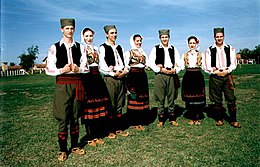
Back Сербтердің дәстүрлі киімдері Kazakh Српски народни носии Macedonian Сербский национальный костюм Russian Српска народна ношња Serbian Сербське національне вбрання Ukrainian
This article should specify the language of its non-English content, using {{lang}}, {{transliteration}} for transliterated languages, and {{IPA}} for phonetic transcriptions, with an appropriate ISO 639 code. Wikipedia's multilingual support templates may also be used. (June 2020) |


| Part of a series on the |
| Culture of Serbia |
|---|
 |
| People |
| Mythology and folklore |
| Cuisine |
| Festivals |
| Sport |
Serbian traditional clothing, also called as Serbian national costume or Serbian dress (Serbian: српска народна ношња / srpska narodna nošnja, plural: српскe народнe ношњe / srpske narodne nošnje), refers to the traditional clothing worn by Serbs living in Serbia, Croatia, Bosnia and Herzegovina, Montenegro, and the extended Serbian diaspora communities in Austria, Australia, Bulgaria, Canada, France, Germany, Greece, Hungary, North Macedonia, Romania, Russia, Slovenia, United States, etc. Like any traditional dress of a nation or culture, it has been lost to the advent of urbanization, industrialization, and the growing market of international clothing trends. The wide range of regional folk costumes show influence from historical Austrian, Hungarian, German, Italian, and Ottoman Turkish presence. Nonetheless, the costumes are still a pinnacle part of Serbian folk culture. From the 19th century and onwards, Serbs have adopted western-styled clothing. This change has started in larger settlements such as cities and towns, although it was not uncommon to see rural women in traditional working costumes all the way until the end of 1970s. Today, these national costumes are only worn by some elderly in rural areas but are most often worn with connection to special events and celebrations, mostly at ethnic festivals, religious and national holidays, weddings, tourist attractions, and by dancing groups who dance the traditional Serbian kolo, or circle dance.
© MMXXIII Rich X Search. We shall prevail. All rights reserved. Rich X Search